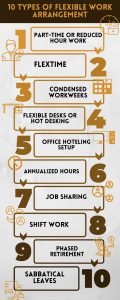Blog

Discover the 10 Types of Flexible Work Arrangements
Businesses have evolved their work arrangement to benefit their employees and the company’s productivity. Employees have become more open to flexible work arrangements, from the traditional five to six days or 40-hour work week to working remotely or through a flexible desks system.
This innovative workplace arrangement motivates different businesses to adapt to them as it benefits a healthier and more balanced work-life routine. And companies see this as an opportunity for their employees to work at their best.
In this blog, learn more about the flexible working arrangement and the different types of it. Read how it helps and gives advantages to the company and the workers.
What is Flexible Work Arrangement?
The flexible working arrangement is an alternative to the traditional fixed working day and place. As the business world continuously grows, companies and employers realize the significant benefits of detaching their employees in the four-wall room.
The flexible arrangement allows employees to have balanced work and personal time. In that way, the employers can decide on the work arrangement where the employees can still have the freedom of managing their time and work. This healthy practice can help the employees condition their selves to bring the best output on time.
This innovative work arrangement is possible in two ways. It can be through specific time scheduling arrangements or via location arrangements. Here are the ten most known flexible work arrangements.
10 Types of Flexible Work Arrangement
1. Part-Time or Reduced Hour Work
The employers will require their employer to render fewer weekly hours than regular full-time employees. This arrangement is time-specific scheduling where the workers usually have a 30 hours cut-off per week. And the location may vary depending on the business.
This type of work arrangement allows employers to have people work for specific jobs requiring extra people for a particular time without hiring them for a full-time position. For instance, some companies have a peak season, where they will need an additional workforce to deliver their regular service. Hiring part-time workers can help them maintain their work quality despite the sudden customer increase.
On the other hand, this work arrangement favors employees willing to earn extra income from their other responsibilities. However, part-time workers usually do not have the same company privileges as full-time workers.
2. Flextime
This type of work arrangement depends on the start and end times of the workday schedule. The employees have their required set of hours per week to complete, but they can accumulate it over a certain period. The company will have a particular time to start and end the work operation. And on that work operation schedule, the employees will have a flexible option on when they will begin and end their workday.
This arrangement can be random and unorganized since the employees will have their choice of time when to work within that day. Hence, most companies using this arrangement have this so-called core time. In the work operation of the company, there is a specific core time when an employee will start their work, and they can choose when to end their workday.
Flextime allows employees to work depending on their time availability. They can work extending their hours to reduce the hours on the next day, as long as they can complete their required hours per week or month.
3. Condensed Workweeks
Condensed or compressed workweeks is another type of work style based on time arrangement. Employees can complete the required 40 hours per week in less than five days. For instance, an employee can only render 10 hours per day for four days. Employees can have an extra day or reduce their daily work expenses in this work style.
This work style is also suitable for extended day-off rather than the expected two-day off. Also, in this arrangement, employees can decide if they can use their day off in the middle of the work week.
4. Flexible Desks or Hot Desking
A flexible desking system is more on location-space work arrangement. The companies usually incorporate a hot desking app, which will help the employee to see if there is available space. This arrangement depends on a first-come, first-served basis.
In this setup, managing space is usually one of its primary benefits. It means that unlike the usual traditional office with a permanent seat per employee, hot desking does not. Usually, this setup is suitable for a company that adapts a hybrid work structure or a mix of on-site and remote arrangements.
5. Office Hoteling Setup
Office hoteling is another work setup for businesses with remote and in-office systems. This arrangement is more on office space management. And like the flexible desk, there is no pre-assigned seating or room per worker. However, this setup is more of a reservation system.
Companies use office booking software since they must reserve their space before work. Hoteling is a cost-effective arrangement, especially for businesses that have limited workspace. However, the company must invest in excellent reservation software to adapt it effectively. Hence, this setup is usually suitable for big corporations that adopt a hybrid work structure or often have traveling workers.
6. Annualized Hours
Annualized hours work style is known for banking hours. This arrangement is usually a setup where the team member and the employer negotiate the maximum number of work hours and days for a specific period. In this setup, there is a combination of flextime and condensed workweek scheduling.
The period can be weekly, monthly, or yearly, depending on the employer’s work requirement. Typically, this work arrangement suits industries with hourly or seasonal peaks.
7. Job Sharing
This work arrangement is usually applicable for some tasks that need immediate completion. The employee will hire two or more part-time workers to complete a full-time job operation. From its name, “job sharing,” the workers can set alternate days or weekly schedules to do the work.
Also, this setup is beneficial for urgent tasks since if one part-time employee is absent, there is someone else who can continue it. Besides that, hiring a part-time worker is also more accessible than a full-time worker, especially if the work is just for a particular occasion.
8. Shift Work
Shift work is an arrangement when dividing a work day into different shifts. An example of shift work setup is splitting a 24-hour business operation into day and night shifts to carry out the duty. The scheduling can also vary depending on the designated working hours made by the employer. The employees can have different working hours from one day to the next or from this week to another.
9. Phased Retirement
This work setup is for workers who will leave or retire from their position. Instead of the usual abrupt retirement from work, the retiring employees will have to reduce their work time and workload. This work arrangement is for the company to train the replacement or help restructure the organization. It is also to delegate some of the tasks to the remaining employees. In that way, the company can function in its normal state.
10. Sabbatical Leaves
Sabbatical leaves are usually beneficial work arrangements for employees. These are the authorized time to leave work without losing employment. Leaves are either paid or unpaid, depending on company regulations. It is a company benefit for the employee to use for a personal occasion.
Takeaway
Flexible desks and time are now the demand for the ever-changing workplaces. Getting the best work operation starts with being open to any work arrangement. Employers should go beyond the traditional way and see how they can provide a more balanced work-life for their employees while achieving peak productivity.















































 Support
Support  Demo
Demo  Blog
Blog 